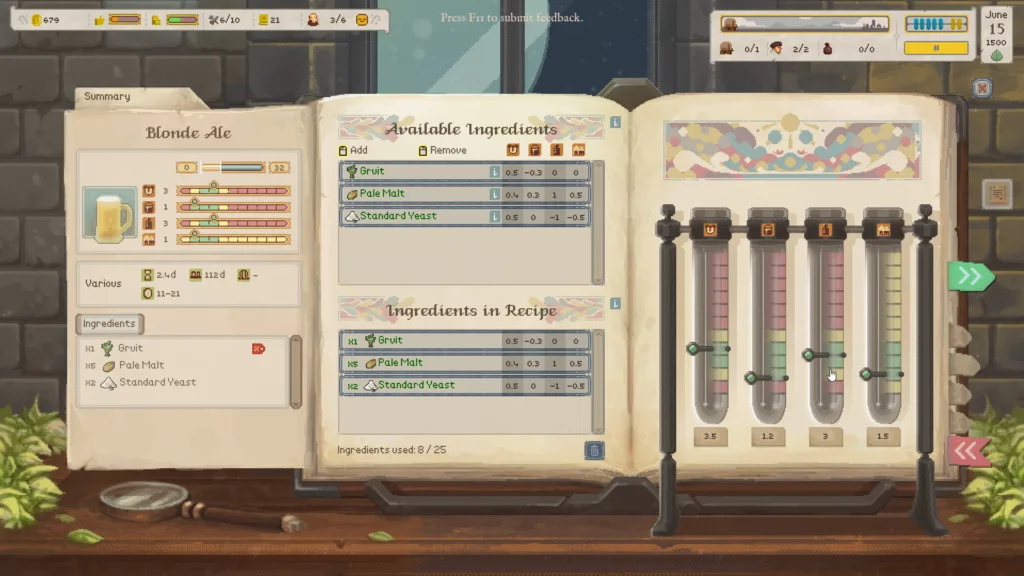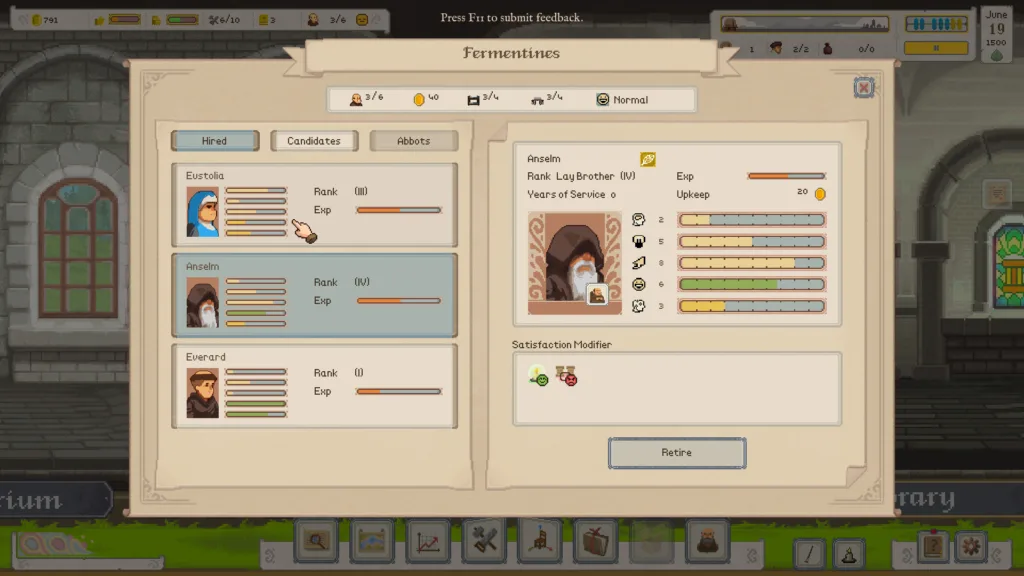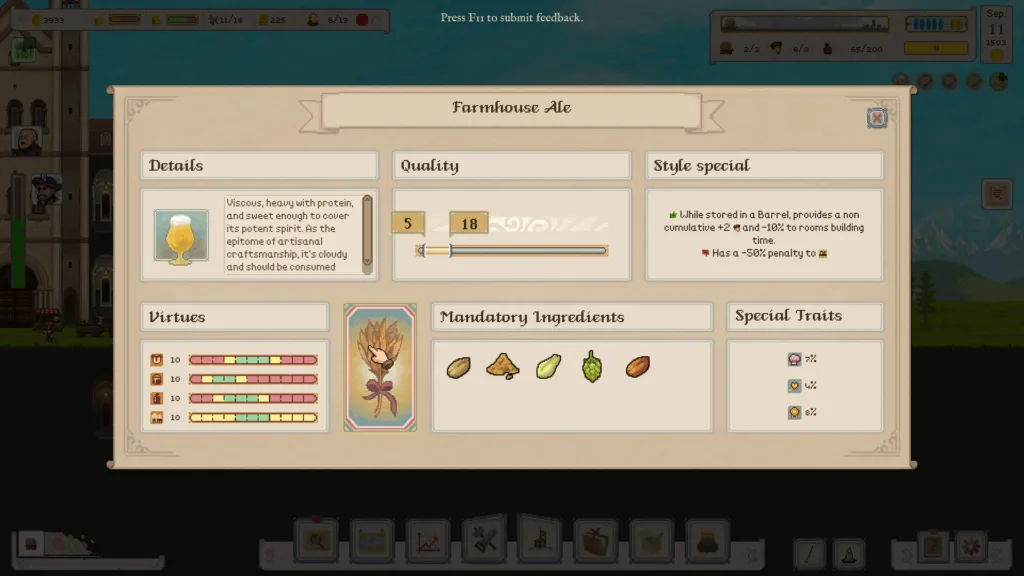If you wanted to, you could divide the vast ocean of video games into two categories. On the one hand, you have fast-moving games that demand quick responses in high-stakes situations, like Silksong or Call of Duty. On the other hand, there are slower, more intentional games that ask you to take your time and thoroughly plan your next move. Ale Abbey falls squarely into the latter group, and it rewards every minute (and hour and day) of gameplay you put into it.
Crack open Ale Abbey’s recipe for success
The point of Ale Abbey is to brew good beer and make some money doing it. Along the way, there are monks and nuns to put to work, recipes to craft, research to investigate, special orders to fulfill, and contests to win. It’s a lot, but the game mostly does a good job of helping you manage it.
Ale Abbey revolves around a few core activities, one of which is creating beer recipes, typically to very specific standards set out by challenges or special orders. Each style of beer has specific ingredient requirements (the cost of which varies by season), which you can tweak to craft something completely unique. The idea is to optimize the attributes/virtues of the beer (flavor, strength, color, and foam) to maximize its quality. Further influencing the quality of a recipe is the competency of the monastic creating it. A major driver of progression throughout the game is creating a recipe for a specific type of beer, the production of which unlocks a new style to brew or market to sell in.




Another core mechanic of Ale Abbey is making the beer. If you want money to pay for your brewery’s upkeep and fund your expansions, you’ll have to sell your beer in the nearby towns and villages. Different towns prefer different styles, so you’ll have to be making different styles all the time, managing your rates as you go. At some point, you’ll need to expand your operations by installing bigger fermenters for bigger batches, hiring additional monastics to handle the work, and purchasing more carts to streamline your shipping.
Along the way, there are lots of things to keep you busy. There’s research to be conducted, which will let you build new rooms, unlock new ingredients, or improve your efficiency. You have to manage the comfort and happiness of your monks and nuns, keeping their quarters clean, making sure they have enough to drink, and ensuring that their lives aren’t too monotonous. There are competitions to enter, orders to fulfill, and bandits to bribe. It’s a lot.



The UI needs to ferment a bit longer
What makes this game really good is its attention to detail. There’s so much going on that you’re never bored, but given that abundance of activity, the UI is very busy. There are so many things to stay on top of that new events can get lost in the hustle of keeping your abbey afloat. I often found myself completely missing a beer order or challenge for minutes simply because I was so absorbed in the minutiae of gameplay. Ale Abbey currently relies on a small set of visual cues to notify you of these sorts of events, but an audio cue might be more effective.
Navigating all the options is mostly intuitive, and I’m grateful that developer Hammer & Ravens kept the hand-holding to a minimum, but there are times when I felt the UI needed a bit more time in the barrel to age. One small grievance I have involves placing objects in rooms. You see, your monastics enjoy lit rooms, so you have to place at least two light sources in the room, but instead of being able to select the candelabra to place, then paying for it each time it’s placed, you have to pay for and place each item, one at a time.


Given the totality of the game, however, these are minor annoyances that are a mere speed bump on the road to brewing bliss. In fact, these small moments of frustration with the interface only stand out to me because, for the most part, Ale Abbey is exquisitely crafted.
The graphics and music create a magical terroir
The world of Ale Abbey is rendered in a charming pixel-art style that simultaneously evokes a medieval vibe and feelings of 16-bit nostalgia. For all that I just complained about the UI, it’s beautifully crafted to feel like it’s part of the world. The beer recipe menu in particular is wonderfully diegetic, made to look like an antique tome.



One of the sparkling jewels of the game is the soundtrack (which you can buy on Steam), composed by certified industry legend Clint Bajakian, whose name you might not know, but whose music you probably do, since he’s worked on everything from LucasArts masterpieces like Day of the Tentacle and Full Throttle to modern Sony classics like God of War and Twisted Metal. The delightful mix of pipes, horns, strings, and choral arrangements immerses you in the world of Ale Abbey, anchoring you to the game’s narrative beats.
Just as important, although not as flashy, is the sound design, which deserves mention for how well it blends into the game without being a distraction. This, too, is thanks to Bajakian, who eschewed synthetic sounds, opting instead for more “rustic” sources for effects.
Should you procure Ale Abbey’s suds?
If you’re looking for a charming, laid-back tycoon game with a satisfying attention to detail, there are few better than Ale Abbey. Aside from the occasional frustrating UI issue, there aren’t a lot of flaws with this title. The worst thing you could say about it is “I don’t play tycoon games,” or “I’m not really into beer,” and even then, I’m sure you could still find something to love.
| Developer | Genre | Price |
| Hammer & Ravens | Tycoon job sim | $14.99 |
Ale Abbey offers up hours of enjoyment and never feels like a drag. The UI can get a bit busy, but that’s just because there’s a lot going on. And yet, despite how many tasks you need to juggle, the game is never overwhelming, and there’s always a sense of progression without the tedium of grinding.






